December 12, 2025
Silicone vs Saline Breast Implants a Complete Patient Guide
Deciding between silicone vs saline breast implants? This guide compares feel, safety, rupture risks, and costs to help you make an informed choice.
Oct 27, 2025
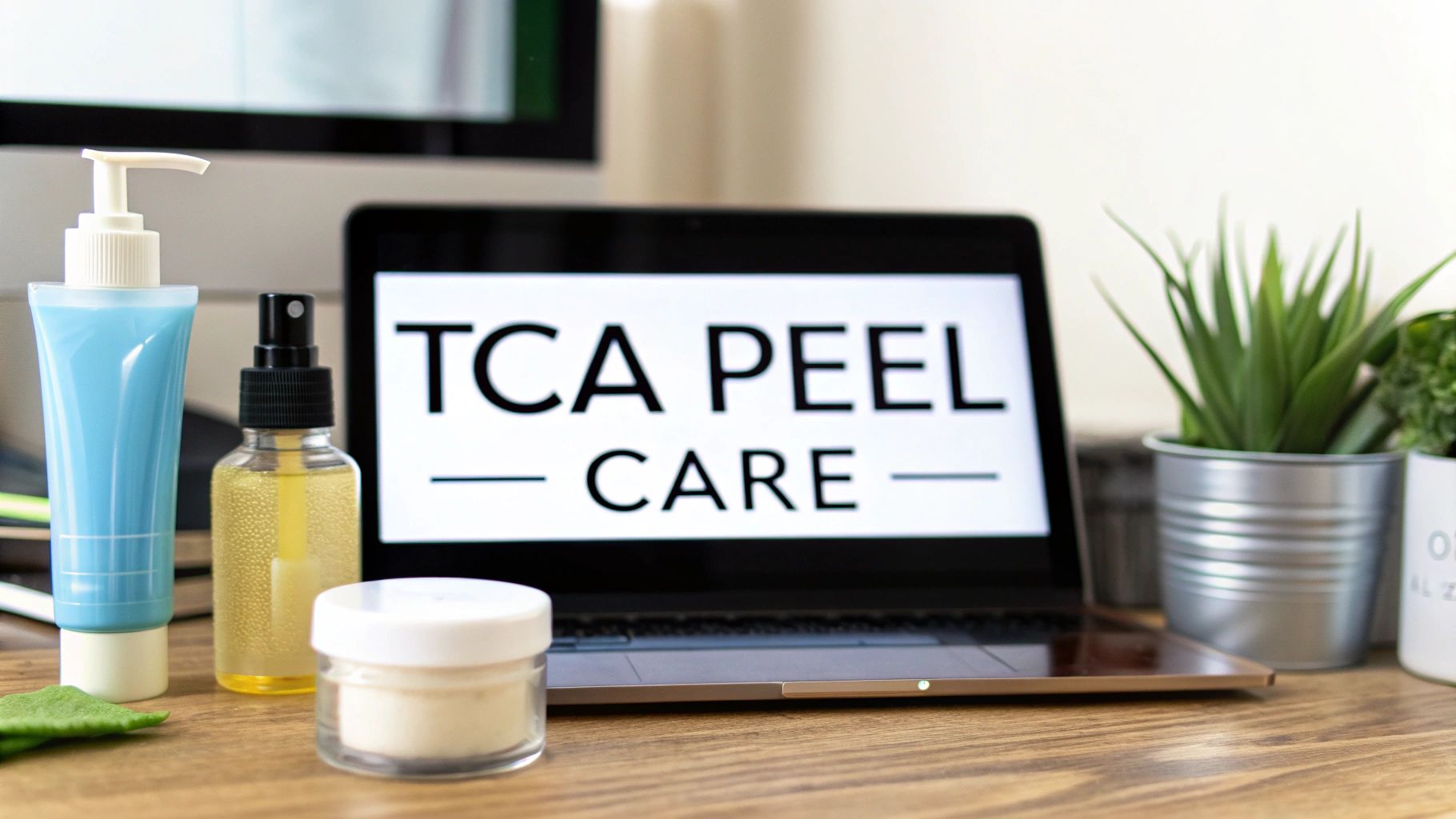
When it comes to getting incredible results from your TCA peel, the treatment itself is only half the battle. How you care for your skin afterward is absolutely crucial. The first 7-10 days are the most delicate period, where your post-care routine will directly shape your final outcome. It all boils down to three things: gentle cleansing, relentless moisturizing, and zero sun exposure.
The first week is when all the action happens. Don't think of it as "downtime"—it's an active healing phase. You're basically guiding your skin as it renews itself, and your diligence here will pay off big time.
For a medium-depth TCA peel, you can expect the whole healing process to take about 7 to 14 days. Your skin will go through some predictable stages, from looking red and feeling tight to the eventual peeling that reveals the fresh skin underneath. The experience is quite similar to other skin resurfacing treatments; you can read more about what to expect during a laser skin resurfacing recovery on our blog.
The timeline below gives a quick overview of what's happening day-by-day.
The first week is a journey. Here's a breakdown of what your skin will likely go through and what you need to do at each stage.
This table is just a guide, of course. Everyone's healing process is a little different, but this gives you a solid idea of the progression.
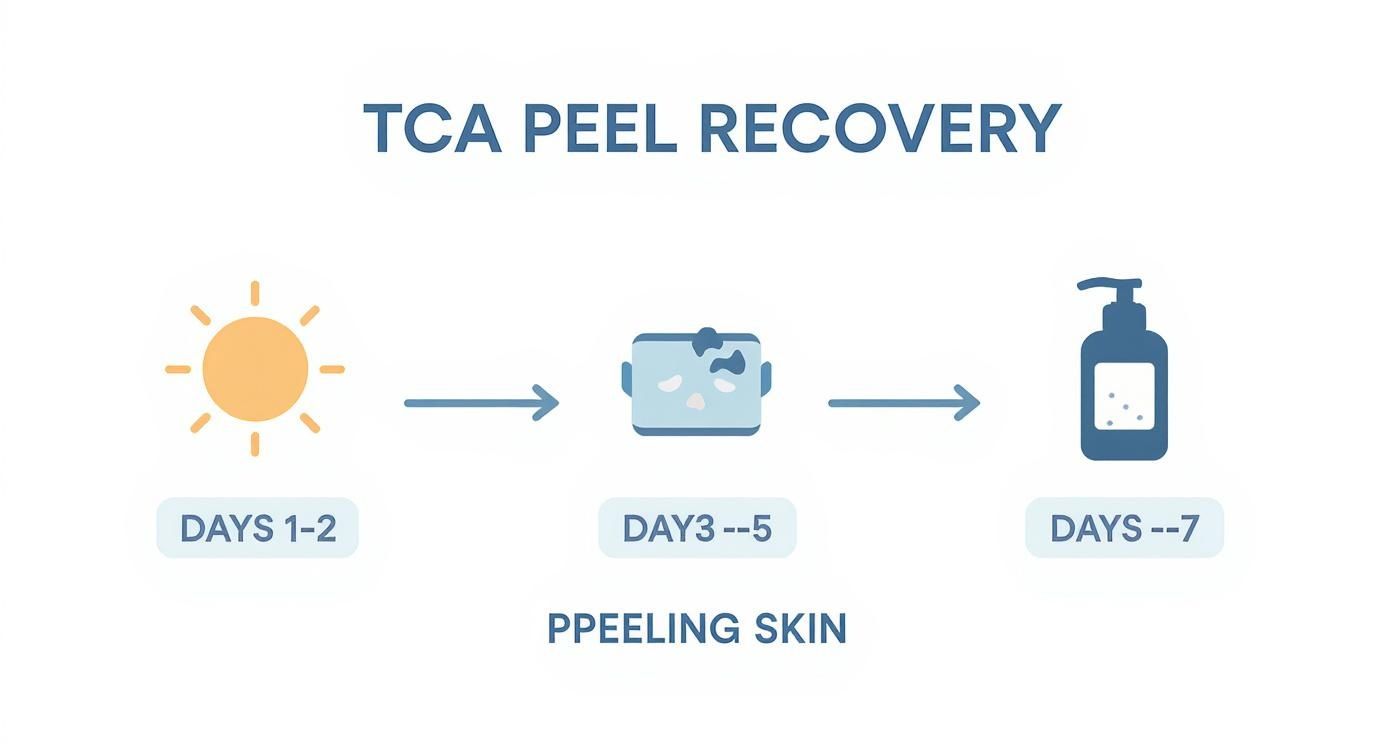
Right after your peel, your skin will look and feel like you got a bit too much sun. It'll be pink or red, feel pretty tight, and might be a little warm to the touch. This is totally normal. For the first 48 hours, your only job is to protect and soothe the area.
Keep your routine dead simple:
Around day three, the peeling finally starts. It's the moment you've been waiting for! You’ll see the outer layer of skin start to flake and peel away, usually beginning around the mouth and nose where your face moves the most.
The temptation to pick at these flakes can be overwhelming. You have to resist.
Picking at peeling skin is the number one mistake people make. If you pull off skin that isn't ready to come off, you risk causing serious damage like scarring, infection, or post-inflammatory hyperpigmentation (PIH). You'll end up with a new problem to fix.
Instead of picking, just keep your skin moisturized with a thick, ceramide-rich cream. If a piece of skin is really bothering you, you can take a pair of small, clean scissors and carefully snip it off. But never, ever pull.
Sunscreen also becomes non-negotiable at this stage. A mineral-based formula with zinc oxide is your best friend here, as it physically blocks UV rays without the potential irritation of chemical sunscreens.
By the end of the first week, most of the peeling should be done. Underneath, you’ll see fresh, smooth, and very pink skin. This new skin is still incredibly fragile.
Continue with your gentle cleansing, moisturizing, and sunscreen routine. You need to steer clear of any active ingredients—that means no retinoids, vitamin C, or exfoliating acids. Your provider will tell you when it’s safe to reintroduce them, but it’s usually at least a few weeks away. For now, your mission is to nurture this new layer of skin as it gets stronger.
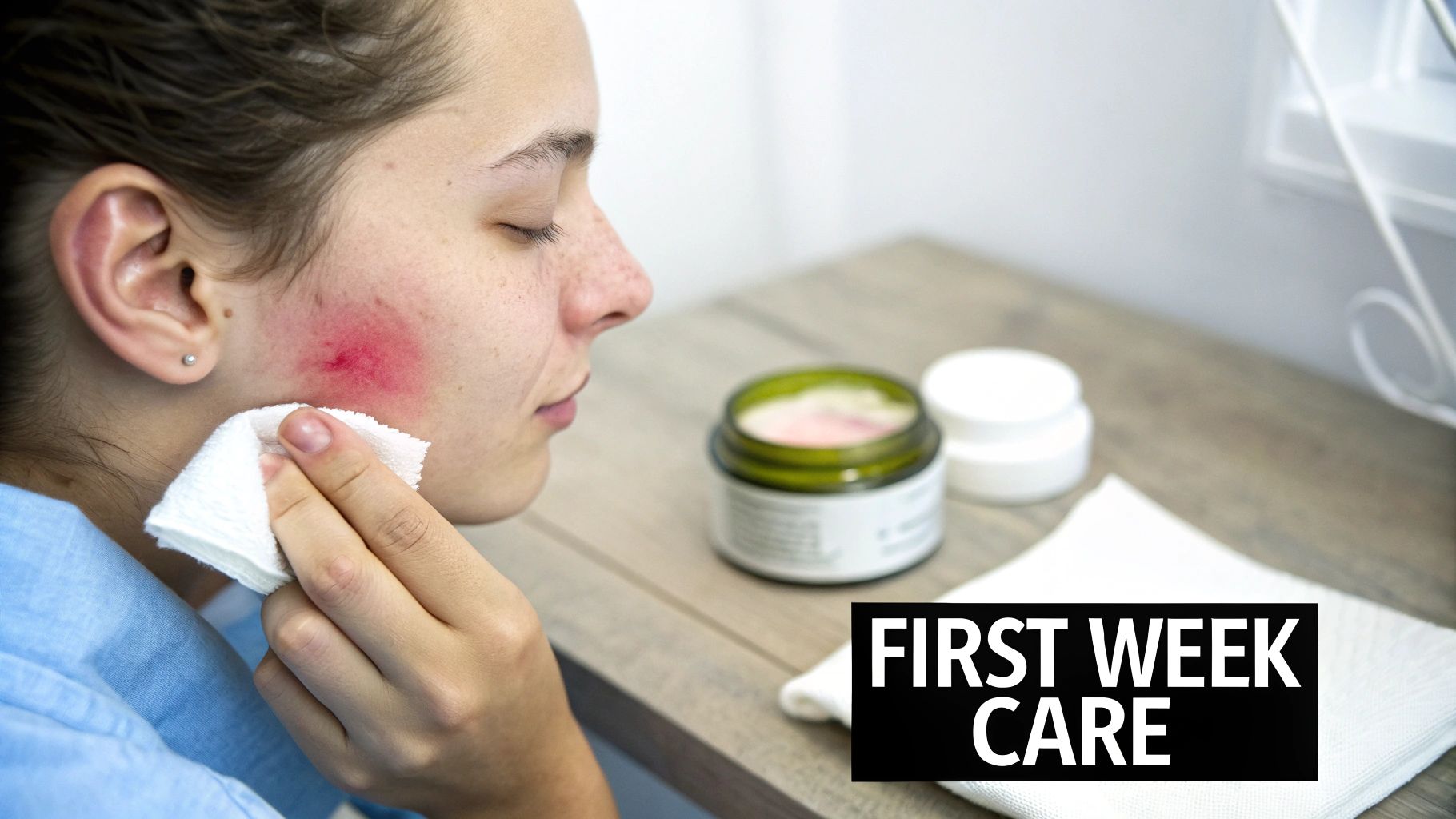
Right after a TCA peel, your skin craves simplicity. Overwhelming it with multiple steps or harsh ingredients can slow healing or spark inflammation. Instead, think of your routine as a calm support system—just a few well-chosen products will do the trick.
Recovery is all about giving your skin room to breathe and rebuild. Focus on:
Gentle, Soap-Free Cleanser
A creamy, non-foaming formula will remove impurities without stripping natural oils. Avoid sulfates and foam boosters that leave skin feeling tight.
Restorative Moisturizer
Look for barrier-friendly ingredients like ceramides, hyaluronic acid, glycerin and squalane. A thick, bland cream locks in moisture and soothes irritated skin.
Mineral Sunscreen (SPF 30+)
Physical filters such as zinc oxide or titanium dioxide form a protective shield without absorbing into sensitive skin. This is non-negotiable—sun exposure can undo all your hard work.
Your post-peel skincare should feel comforting, not active. If a product stings, tingles or causes redness, stop using it immediately. Your skin is communicating its needs, and right now it needs peace and quiet.
In those first 7–14 days of healing, simplicity wins. Ditch any ingredient that might tug at your fresh, vulnerable skin:
By steering clear of these, you minimize irritation and give your skin a clear path to recovery.
Below is a quick-reference guide to help you choose products wisely. It highlights ingredients that support healing versus those you’ll want to sideline.
With this at-a-glance chart, you’ll know exactly what to reach for during each healing stage—and what to keep on the shelf.
Recovery doesn’t last forever. Once your skin has settled, reintroduce options slowly. And when you’re ready for makeup, look into hypoallergenic makeup designed for sensitive skin. For a deeper dive into chemical peels and who they suit best, visit our guide on what they do and who they're for.
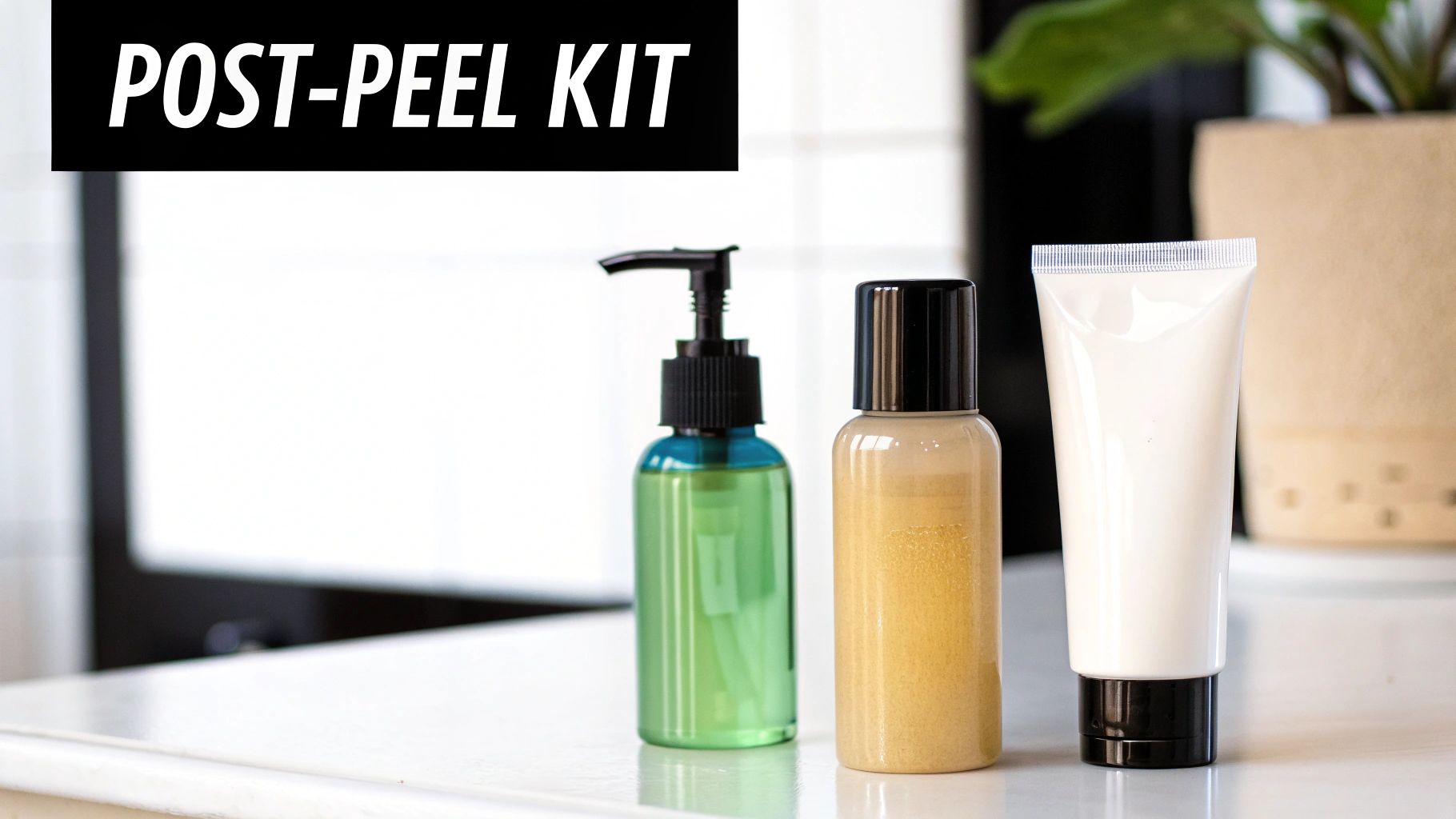
The success of your TCA peel doesn't stop when you leave the clinic. What you do at home—your daily habits—is just as crucial as the products you put on your face. Think of the next week or two as a dedicated "skin retreat." It requires a few simple, yet non-negotiable, lifestyle tweaks to protect your investment.
The absolute number one rule? Strict sun avoidance. I can't stress this enough. Your new skin is incredibly sensitive to UV rays, and even a few minutes of unprotected exposure can trigger hyperpigmentation, essentially undoing the benefits of your peel.
While a good mineral sunscreen is your best friend, it’s only part of the solution. You need to actively seek out shade, make a wide-brimmed hat your go-to accessory, and seriously consider postponing that beach trip or outdoor lunch.
Just like you need to dodge the sun, you also need to avoid getting sweaty. Anything that raises your body temperature and increases blood flow to the face can dial up inflammation, redness, and that uncomfortable tight feeling.
Even worse, sweat itself can be a major irritant on healing skin, causing stinging or even tiny blisters.
For the first week, you’ll need to put a pin in your usual routine. This means:
Gentle walks are fine, but if you feel yourself starting to break a sweat, it's time to head back inside. This small sacrifice pays huge dividends for a calm, smooth healing process.
From my experience, the biggest psychological hurdle for patients is the overwhelming urge to pick at flaking skin. It's so tempting, but pulling it off before it's ready can tear away healthy tissue, leading to scars and dark spots. You have to let it shed on its own timeline.
Beyond what you shouldn't do, a few proactive habits can make you more comfortable and boost your results. Drinking plenty of water is a simple one, but it truly helps your skin heal and stay hydrated from the inside out.
Here’s another pro tip: try sleeping with your head slightly propped up on an extra pillow. This little trick uses gravity to help reduce any puffiness or swelling you might wake up with in the morning.
These lifestyle adjustments are exactly why a solid tca peel post care plan is so vital. Chemical peels are incredibly popular—dermatologists performed nearly 130,000 in the U.S. back in 2018. The people who get the best results are always the ones who follow the aftercare instructions to the letter.
Proper care, especially diligent sun protection, is your insurance policy against complications. It ensures you get the smooth, glowing skin you paid for. You can learn more about the importance of post-peel care and how it directly impacts your final outcome.

When recovery kicks in, a bit of tightness, mild swelling and that incessant itch are par for the course. These sensations aren’t pleasant, but they signal your skin is working overtime to heal itself after a TCA peel.
The urge to scratch can feel overwhelming, yet touching or picking at peeling skin risks scarring and infection. Instead, reach for a thermal water spray—a few light mists can calm irritation instantly without any hands-on contact.
A simple cool compress often makes the biggest difference for both heat and puffiness. Grab a clean, soft cloth, soak it in cool (not icy) water, then gently press it against your cheeks or forehead for a couple of minutes.
Keep these pointers in mind:
If that itch won’t quit—especially when you’re trying to sleep—don’t hesitate to call your provider about adding an over-the-counter oral antihistamine to your nightly routine. It can help quiet the itch from the inside so you’re less tempted to scratch.
Mild redness, a bit of tightness and light flaking are all expected signs of healthy regeneration. If you notice severe pain, yellow discharge or heavy crusting, reach out to your doctor right away.
Understanding what’s normal helps you relax and stay on track. A light pink glow and gentle peeling mean collagen is building beneath the surface. When you follow gentle, doctor-approved methods, you support a smooth recovery—and a final result you’ll love.
So, the peeling has stopped, and your skin is feeling incredibly smooth. What now? While it's tempting to think the hard part is over, your work has just shifted. The beautiful, glowing results you see are a direct product of your meticulous tca peel post care. Keeping that glow requires a smart long-term strategy.
Think of it as moving from a healing phase to a maintenance phase. The first step is to carefully, and I mean carefully, reintroduce your more powerful skincare products. Don't just dive back into your old routine. Your new skin is still delicate and will be for a few more weeks. Rushing it is a surefire way to cause irritation and redness, which can undo all your hard work.
The timeline for bringing back your go-to active ingredients is everything. For most of my patients, a gentle vitamin C serum can usually make a comeback around two weeks after all the peeling has finished. It's a fantastic antioxidant that helps shield those fresh, new skin cells from daily environmental stress.
But for the heavy hitters, you need to show some serious patience.
When you do start using them again, don't go all in. Start slow—maybe just two or three times a week—and pay close attention to how your skin responds before you ramp up the frequency.
If there's one thing you take away from this, let it be this: daily sunscreen is non-negotiable. It is the single most important habit for protecting your results. Think of it as the ultimate insurance policy on your investment, shielding your new skin from sun damage and preventing new spots from forming.
Consistency is what separates good results from great, long-lasting ones. Studies looking at TCA peels for conditions like melasma have shown time and again that a strict post-care routine—especially topical treatments and sun protection—is what keeps the condition from coming back. You can actually see some of the findings on TCA peel efficacy in published research. The same logic applies if you've had a chemical peel for freckles; diligent aftercare is what keeps that complexion clear and bright.
And remember, what you put in your body matters, too. A holistic approach can make a real difference. It might be worth looking into how things like supplements for healthy aging can support your skin's health from the inside out.
Ultimately, your long-term maintenance doesn't need to be overly complicated. By making sunscreen a daily ritual, thoughtfully reintroducing your active ingredients, and planning for future maintenance treatments with your provider, you can enjoy that radiant, post-peel skin for a very long time.
A TCA peel recovery is usually pretty predictable, but it's crucial to know the difference between what's normal and what's a red flag. Following your TCA peel post care instructions is your best defense, but sometimes you need to call in the professionals.
https://www.youtube.com/embed/9Mcxm44O240
Feeling tight, looking red, and having some general discomfort is all part of the healing process—it’s a chemical peel, after all! But if that discomfort turns into real, persistent pain that over-the-counter medication can't touch, that’s not normal. You need to let your dermatologist know right away.
The other major thing to watch for is any sign of infection. This isn't something you "wait and see" on.
An immediate call to your doctor is necessary if you experience any of the following:
Beyond infection, there are a few other issues to keep an eye on. Some swelling is perfectly normal, particularly when you first wake up. However, extreme puffiness that gets worse instead of better is a cause for concern. The same goes for blisters—if you see any forming, that’s your cue to call your doctor.
Another potential complication that can pop up is post-inflammatory hyperpigmentation (PIH). This shows up as new, dark patches of skin after the main peeling has finished.
If you start noticing new dark spots or splotchy areas as your new skin is revealed, don't just hope it goes away. Contact your dermatologist. Catching PIH early gives you a much better chance of correcting it effectively before it becomes more permanent.
By staying vigilant during your recovery, you can feel confident in the healing process. You'll know exactly when to trust your body to do its thing and when it's time to pick up the phone.
Even with the best instructions, you’ll probably have a few questions pop up as you heal. That’s perfectly normal. Here are some quick answers to the questions we hear most often from our own patients.
We always tell our patients to wait at least 12-24 hours before that first wash, but your provider's specific timeline is the one to follow.
When you do get the green light, think gentle. Use only cool water and a mild, creamy cleanser—absolutely no scrubs or foaming washes. Lather it with your fingertips, rinse, and then carefully pat your skin completely dry with a clean, soft towel. No rubbing allowed, as that can easily irritate your fragile skin.
This is one of the most common worries we hear, and the answer is simple: it’s not supposed to! Skin isn’t uniform.
Your T-zone, for instance, is usually oilier and thicker than the skin on your cheeks. As a result, you might see significant flaking on your cheeks and forehead but barely any around your nose. Don't panic. A lack of dramatic peeling doesn't mean the treatment didn't work. The chemical exfoliation is happening deep down at a cellular level, regardless of what you see on the surface.
Remember, the goal isn't just to see skin flake off. The real magic of a TCA peel is how it stimulates new collagen and renews your complexion from within. The peeling is just a side effect, not the main event.
I know it's tempting to cover up the redness, but you absolutely must wait until the peeling process is 100% complete. That means no more flaking, and the underlying skin is no longer pink or sensitive.
For most people, this takes about 7 to 10 days. Putting makeup on healing skin is a recipe for disaster—it can cause major irritation, clog your freshly revealed pores, and even lead to infection. Once you’re fully healed, we recommend starting with a gentle mineral-based makeup, which is much kinder to new skin.
At Cape Cod Plastic Surgery, we guide you through every step of your skin rejuvenation journey, ensuring your aftercare is as meticulous as your treatment. Learn more about our advanced skin treatments.
December 12, 2025
Deciding between silicone vs saline breast implants? This guide compares feel, safety, rupture risks, and costs to help you make an informed choice.

December 12, 2025
Inspiring Journeys: How Real Patients Achieved Remarkable Transformations
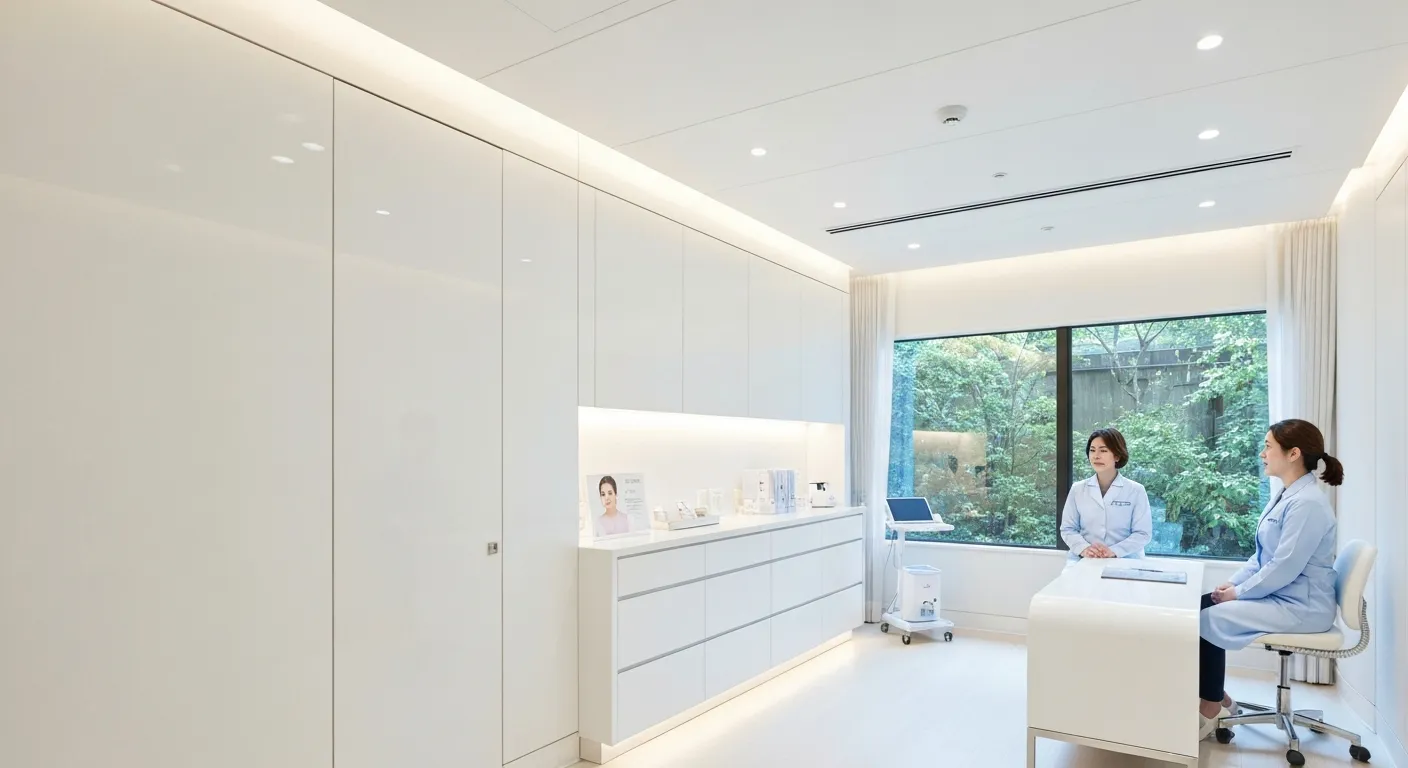
December 12, 2025
Real Stories of Life-Changing Transformations Through Plastic Surgery